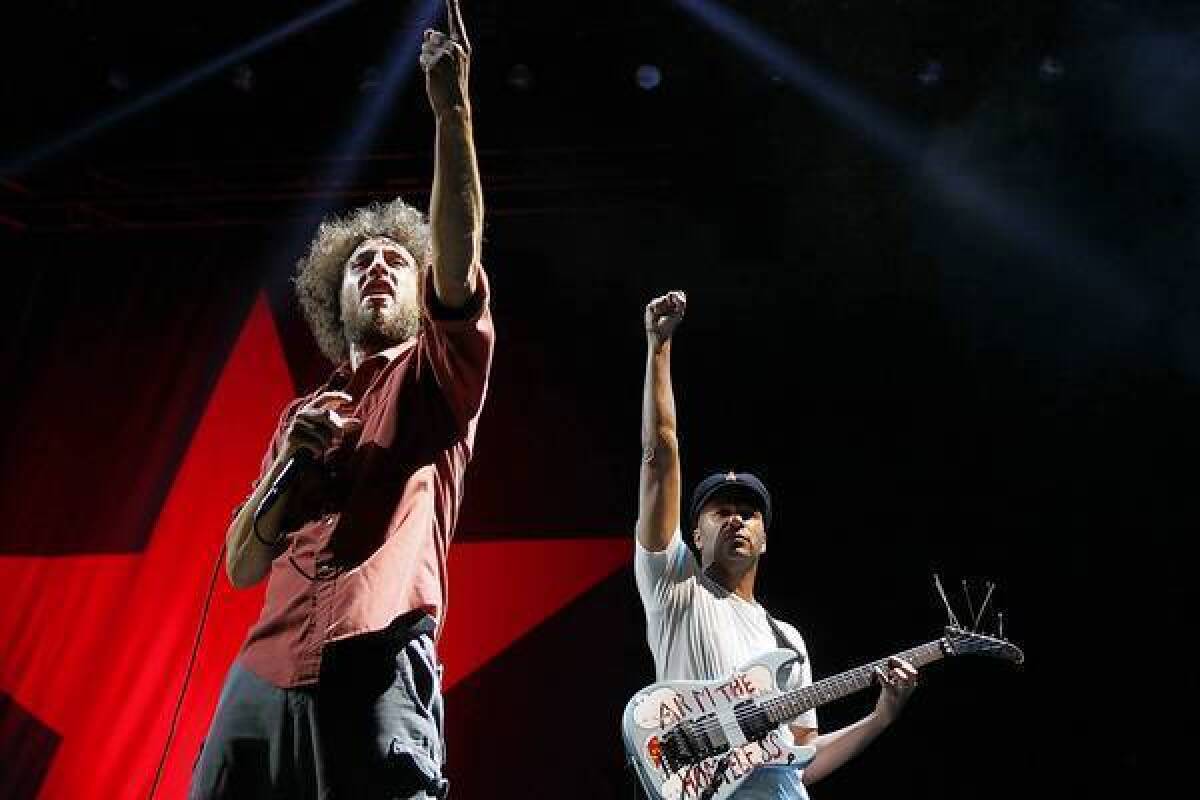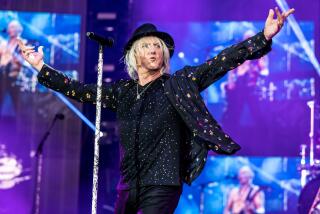Rage Against the Machineâs fiery legacy

Twenty years ago this month, Rage Against the Machine released its self-titled debut album, a searing collision of hip-hop, funk and hard rock mixed with a pointed political invective. In a bit of timing that was maybe part coincidence and part destiny, it arrived in the wake of the L.A. riots.
But even before Florence and Normandie erupted in April 1992, the local band was warning of the conditions that would give birth to the riots, not unlike the socially minded hip-hop of the time. The Rodney King verdict may have been the spark, but it was years of frustration among the economic underclass of South Central Los Angeles that fueled the uprising.
Now, for better or for worse, Rage Against the Machineâs legacy is intertwined with that of the riots.
Itâs a connection thatâs evident across a sprawling, four-disc special edition of that debut album released Tuesday. The collection is full of live footage and rarities as well as the demos that became the bandâs debut.
PHOTOS: Celebrity portraits by The Times
But to back up a bit, before Rage Against the Machine exploded across alternative music, there was a telling moment that underscored the bandâs connection with the riots.
It was in early May 1992, when Pearl Jam played a sold-out show at the Hollywood Palladium that helped feed the Seattle bandâs meteoric rise to arena rock prominance. Although the cathartic night of music was memorable, the show remains colored by the fragile state of the city at the time, just weeks after the riots. Though the venue didnât go up in flames, there was a question as to whether thereâd still be a show that night, considering that a number of other businesses on Sunset Boulevard were closed, their windows boarded up.
Standing shoulder-to-shoulder, the crowd around the stage was restless and already aggressively knotting against one another to the music over the PA when Rage Against the Machine took the stage before the headliner. Though some in attendance may have been familiar with the L.A. band, most of Pearl Jamâs KROQ- and MTV-informed audience likely never saw Rage Against the Machine coming.
The band tore into a ferocious set, guitarist Tom Morello unleashing an unholy racket that recalled both Jimi Hendrixâs âStar Spangled Bannerâ and the Bomb Squadâs apocalyptic soundscapes for Public Enemy. Frontman Zack de la Rocha â wild-eyed, wriggling and intense â roared as he exhorted the crowd to wake up, question authority and know your enemy. The mosh pit, that eraâs volatile measuring stick of audience response, consumed most of the Palladiumâs floor in delirious chaos.
PHOTOS: Hollywood backlot moments
In that moment, Rage Against the Machine sounded less like a rising local band than a raw manifestation of the city, a cathartic blend of sound and fury that needed to be heard.
Among the reissued albumâs extras is a grainy, VHS-quality document of the bandâs first performance at Cal State Northridge in 1991, and although the crowd is an amusing time capsule of the eraâs antifashion, the video feels strangely prescient as De La Rocha introduces an early version of âTownship Rebellionâ with references to social inequality in South Central L.A.
The boxed setâs demos reveal many of the songs from that first album as close to fully formed, and although some of the bonus tracks are interesting, others, such as the gruff reggae of âMindsetâs a Threat,â make for odd curios. With its mashup of sound and styles, the group has been blamed for hatching the odious rap-rock subgenre and its Woodstock â99-born legacy of destruction for destructionâs sake, but Rage shouldnât be any more discounted for that legacy than Led Zeppelin can for the hair metal era.
Still, for all the magic the group harnessed, its timing wasnât always so perfect. After two additional albums of righteous, polemical funk-rock and a covers collection (were you expecting a love song?), the group disbanded in 2000, arguably right as its opposition politics couldâve risen to even greater heights in the post-9/11 era.
On the surface, the groupâs â90s heyday was marked by comparative prosperity, but as the war on terror and issues of human rights and privacy grew in prominence after that, Rage Against the Machine had dissolved into the ploddingly apolitical Audioslave (which featured three-quarters of the band, fronted by Chris Cornell in place of De La Rocha) and Morelloâs folk-tilted Nightwatchman project. Looking back, the bandâs Michael Moore-directed video for âSleep Now in the Fireâ from 2000 again seems prophetic, featuring the group performing amid a tight police presence in New Yorkâs financial district and protesting income inequality years before Occupy Wall Street.
The group reunited for an electric and heavily secured set at the 2007 Coachella festival; that performance underscored that no group of the last 20 years had tapped the sound of unrest and rebellion quite like Rage Against the Machine. However, although the band has since played a variety of festival dates along with its own L.A. Rising festival last year, there remain no plans for new music.
Still, what began 20 years ago with a lightning rod connection between a band and history has become something indelible. Could Rage Against the Machine ever bring about the changes it so furiously demanded? Maybe not, but even now, listening to the bandâs impassioned music, it sounds possible.
PHOTOS AND MORE
PHOTOS: Iconic rock guitars and their owners
The Envelope: Awards Insider
PHOTOS: Unfortunately timed pop meltdowns
More to Read
The biggest entertainment stories
Get our big stories about Hollywood, film, television, music, arts, culture and more right in your inbox as soon as they publish.
You may occasionally receive promotional content from the Los Angeles Times.











